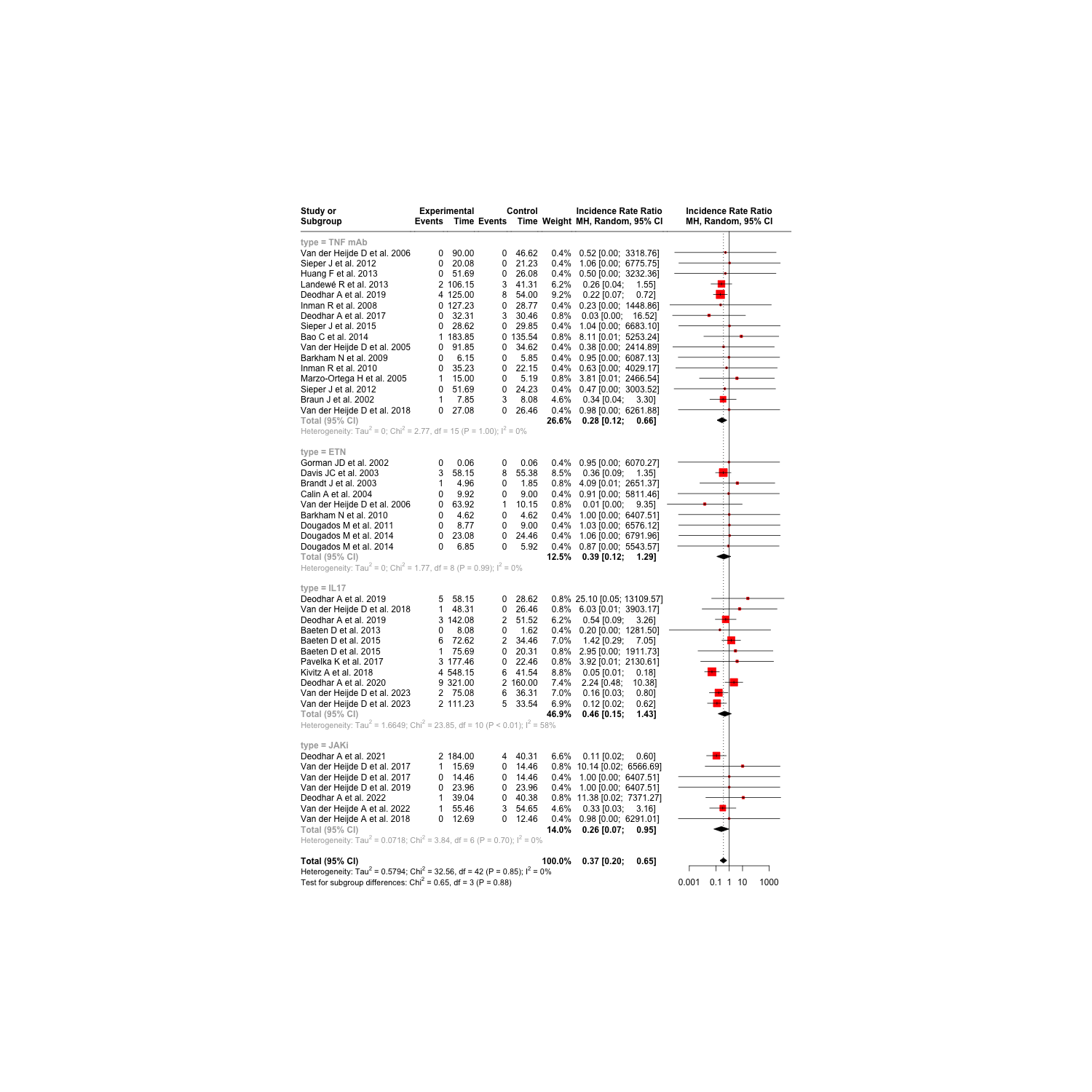Session Information
Date: Tuesday, November 14, 2023
Title: Abstracts: Spondyloarthritis Including Psoriatic Arthritis – Treatment III: AxSpA
Session Type: Abstract Session
Session Time: 4:00PM-5:30PM
Background/Purpose: Anterior uveitis (AU) is one of the commonly observed extraspinal manifestations in Axial spondyloarthritis (AxSpA). Data on the protective effects of targeted immunomodulatory therapies at reducing the frequency of AU flare is limited, particularly amongst more recently licensed drugs. The objective of this study was to investigate the incidence of AU in AxSpA patients treated with etanercept, anti-TNF, anti-IL17A and JAK inhibitors, and compare the protective effect between therapies.
Methods: Embase and MEDLINE were systematically searched to identify all RCTs assessing etanercept, anti-TNF, anti-IL17A and JAK inhibitors drugs in patients with AxSpA. The primary outcome of interest was AU events. Patient exposure years were calculated using a per-protocol analysis. Meta-analysis was performed to compare treatments with placebo. A fixed continuity correction of 0.1 was applied to each RCT arm with zero events. Crude incidence (IR) was calculated. Relative risk between the treatment arm and placebo was estimated and expressed as incidence rate ratios (IRR). Network meta‐analysis (NMA) was employed to allow indirect comparisons between the therapies.
Results: Forty-three studies with 9,184 participants met the inclusion criteria. The IR of AU per 100 patient-years were 1.0 [95% CI: 0.4, 1.8] for anti-TNF, 3.2 [1.2, 7.0] for etanercept, 2.2 [1.5, 3.0] for anti-IL17, 1.4 [0.5, 3.4] for JAK inhibitors, and 4.3 [3.3, 5.6] per 100-person years in the pooled placebo group. Compared with placebo, anti-TNF and JAK inhibitors had an IRR of uveitis: 0.28 [0.12, 0.66] for anti-TNF and 0.46 [0.07, 0.95] for JAK inhibitors. A lower but non-significant IRR was seen with etanercept (0.39 [0.12, 1.29]) and anti-IL17(0.46 [ 0.15, 1.43]) (Figure 1). Indirect comparisons between the treatment arms using network meta-analysis did not demonstrate any significant difference in risk of uveitis between different treatment arms.
Conclusion: Targeted immunomodulatory therapy is protective against AU flare. The greatest effects are seen with anti-TNF and JAK inhibitions, although indirect comparisons do not demonstrate any significant difference between treatment modalities.
To cite this abstract in AMA style:
Yang Z, Adas M, Katie B, Nagra D, Uguzlar A, Russell M, Wilson N, Steer S, Norton S, Galloway J. The Incidence of Uveitis in Patients with Axial Spondylarthritis Treated with Biologics or Targeted Synthetics: A Systematic Review and Network Meta-analysis [abstract]. Arthritis Rheumatol. 2023; 75 (suppl 9). https://acrabstracts.org/abstract/the-incidence-of-uveitis-in-patients-with-axial-spondylarthritis-treated-with-biologics-or-targeted-synthetics-a-systematic-review-and-network-meta-analysis/. Accessed .« Back to ACR Convergence 2023
ACR Meeting Abstracts - https://acrabstracts.org/abstract/the-incidence-of-uveitis-in-patients-with-axial-spondylarthritis-treated-with-biologics-or-targeted-synthetics-a-systematic-review-and-network-meta-analysis/

